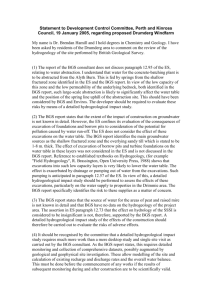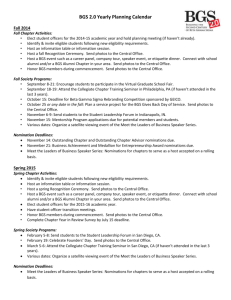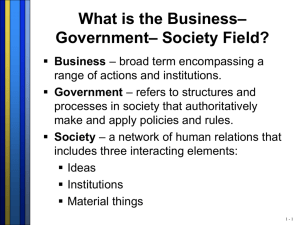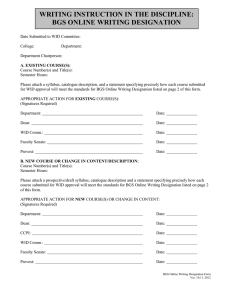Minutes of Meeting of Licensing Forum 5 February 2008
advertisement
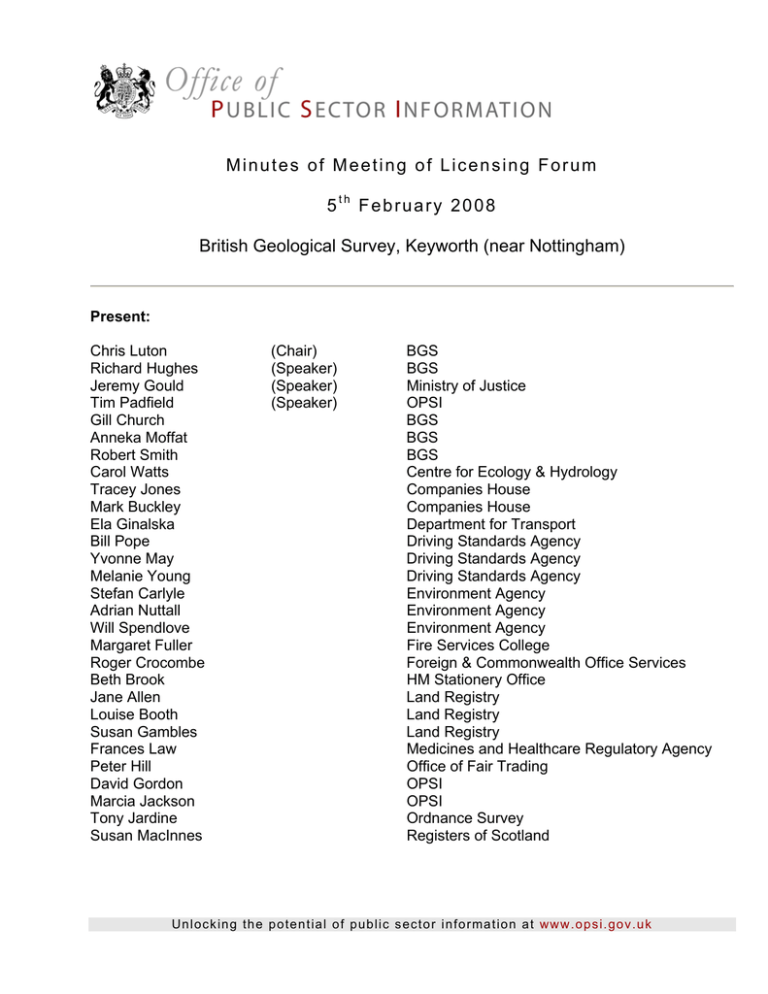
Minutes of Meeting of Licensing Forum 5th February 2008 British Geological Survey, Keyworth (near Nottingham) Present: Chris Luton Richard Hughes Jeremy Gould Tim Padfield Gill Church Anneka Moffat Robert Smith Carol Watts Tracey Jones Mark Buckley Ela Ginalska Bill Pope Yvonne May Melanie Young Stefan Carlyle Adrian Nuttall Will Spendlove Margaret Fuller Roger Crocombe Beth Brook Jane Allen Louise Booth Susan Gambles Frances Law Peter Hill David Gordon Marcia Jackson Tony Jardine Susan MacInnes (Chair) (Speaker) (Speaker) (Speaker) BGS BGS Ministry of Justice OPSI BGS BGS BGS Centre for Ecology & Hydrology Companies House Companies House Department for Transport Driving Standards Agency Driving Standards Agency Driving Standards Agency Environment Agency Environment Agency Environment Agency Fire Services College Foreign & Commonwealth Office Services HM Stationery Office Land Registry Land Registry Land Registry Medicines and Healthcare Regulatory Agency Office of Fair Trading OPSI OPSI Ordnance Survey Registers of Scotland U n loc k in g th e po t en t ial o f p ub lic s ec t or i n for ma t ion a t www .o psi.go v.uk Introductions • 1. The Chair (Chris Luton) offered preliminary greetings to delegates and, after some health and safety information, introduced the first talk. An Introduction to Copyright: Legal Principles and Case Studies Tim Padfield, Office of Public Sector Information • Tim Padfield started his talk by establishing the basic principles behind the concept of copyright. It cannot just be an idea or a fact, but needs to be set in a material form: it also has considerable longevity, normally well beyond the death of the originator. The potential benefits of clearly identifying copyrighted work are clear, with author JK Rowling having made an estimated £450 million from her use of Harry Potter. • However, there must also be clarity when asserting your rights. Madame Merlet designed a cape to protect her small children from rain: Mothercare took the design and made a commercial version based on it. She sued them on the basis that it was a work of artistic craftsmanship, but lost as the original was neither artistic nor a work of craftsmanship, so it did not qualify as a ‘work’ at all. Had she pressed a claim of copying the drawings, the outcome may have been different. • Broadcasts and sound recordings also count as works which may be copyrighted. The most common categories are literary (which are composed of text or may also include be numbers as in computer programs, or symbols, for example the illustrations of a comic strip) and artistic (photography, maps, sculptures and buildings are all valid examples). • As a point of interest, signatures may count, but would be considered artistic rather than literary works, as the literary content is only the name. Therefore, to count as a copyrighted piece, they must be more than just the individual’s name in her normal handwriting but should feature unusual use of script. • In addition, more than one form of copyright may be merged within one work. For example, a poem about a cat which is also designed to be written in such a way to form a drawing of a cat is both literary and artistic. Songs include both literary (lyrics) and artistic (music) aspects, whilst opera may include 4 forms: the dramatic instructions (librettos) are dramatic works and count as another form of copyright. • Typographical arrangements are also copyrighted material, although this only lasts for 25 years. These must be published editions though, and web pages do not count: however, the layout of GIS information may be valid. As an example, the computer program which generates a series of randomised lines for a screensaver may be protected as a literary work. However, the random shapes are never fixed and would not be artistic works. • Registration is not a requirement for material to be protected by copyright. As soon as a piece of work has taken a fixed form, it has potentially gained copyright status: the system of registration ceased in the UK in 1912. The Berne Convention does not require the use of theto label ©, with name and date, although such identification is a sound policy. Most U n loc k in g th e po t en t ial o f p ub lic s ec t or i n for ma t ion a t www .o psi.go v.uk countries are signatories to the Berne Convention, although some gaps (e.g. Afghanistan, Iraq, and San Marino) do exist. • The work must be original, but this does not mean it must be unique. As an example, if several people took a photograph of the same object from the same angle, each image could be copyright protected: however, photocopies of these photographs would not count. This nuance can cause problems, with the National Portrait Gallery claiming that postcards of works in its collection are copyright. This policy is dependent on there having been sufficient skill in the creation of the copy, and it is one which the National Archives do not follow (except for cases where complex arrangements were required for the replica to be made). In another famous case, James Joyce produced several drafts of his famous work ‘Ulysses’, which differed significantly from each other. As a result, each of these is now recognised as a separate piece of copyrighted material. • In terms of defining the ‘author’ of a piece of work, this is the creator, but the creator is not easy to identify in all cases. In 1881, a photographer was sent to take pictures of the Australian cricket team. However, another company then copied the image. The company which commissioned the image had registered its partners as the authors of the image but the court found the. Photographer to be the author. In addition, anyone merely recording material created by someone else is not the author, but rather it is the person dictating. • The standard term of copyright is for the life of the author plus another 70 years. It has been estimated that the oldest piece of literary copyrighted material currently in existence in the UK is ‘The Clinical Teaching of Psychology’ from 1862, where the copyright will lapse at the end of 2008. Unpublished literary works used to have permanent protection, which has been changed but will still last until at least 2039. Crown copyright material is protected for 50 years from the date of publication or until 2039 at the earliest if it is unpublished. These questions can cause major problems for archivists. Films are subject to other separate provisions. • Crown copyright material gives the employer the rights, not the employee. The definition has changed slightly: until 1989, it was anything produced ‘under the direction or control’ of the Crown, but this has been amended to work undertaken ‘in the course of duties’. Ownership of an artefact does not automatically translate into ownership of copyright (e.g. letters). • Copying, issuing copies or communicating copyright material to the public is not allowed under the law. Websites are not in themselves copyright works, although the material therein is likely to be protected. There used to be protection under the guise of cable program services, but this no longer applies. • There is no infringement by using an ‘insubstantial’ part of a work. It should be borne in mind here, though, that this definition is more about quality than quantity. As an example, (if it were protected by copyright) if someone took a small piece from the background of the Mona Lisa and applied it to their piece of art, then this may well be acceptable. However, an extract that was the same size but contained the famous enigmatic ‘smile’ would be an infringement. This matter is notoriously open to debate, and would be a matter for courts to decide. • There is also the exception of ‘fair dealing’, which has several possible elements. These are non-commercial research, criticism, review, private study and current news reporting. U n loc k in g th e po t en t ial o f p ub lic s ec t or i n for ma t ion a t www .o psi.go v.uk • Another complex area is that of ‘moral rights’. In Crown copyright material, the author may have the right to claim authorship if their name is on the title page. In a French case, the film ‘Asphalt Jungle’ was made in black and white, and was a stylised piece of work. When someone applied to add colour to the work, the original director asserted their moral rights, arguing that this would destroy the atmosphere created by monochrome. The court agreed: however, this concept is weaker in British law and may be harder to assert. • Databases can be both copyright protected and also be subject to database rights. The copyright would lie in the design of the database, whilst the database rights are held in the content (but only if there has been significant investment to generate this). In one case, the British Horse Racing Board sued William Hill for using its data, but lost as the court held that the database had been created to facilitate the running of races. 2. ‘Social Media’ and ‘Web 2.0’ In Government Jeremy Gould, Ministry of Justice • Jeremy Gould is in charge of Web Development at the Ministry of Justice, and the results of this work are available at www.justice.gov.uk. This site is updated daily, and has demonstrated the opportunities for the Ministry of Justice and wider Government to expand their electronic communications. • In the wider context, Social Media has been expanding since around 2006, with many of the associated websites (e.g. Facebook, MySpace, Wikipedia) now being widely recognised names or brands. These innovations are also often labelled as ‘Web 2.0’, which (in generalised terms) means that the user is changing from mere consumer to a producer of information. • Therefore, the first question is ‘what is social media?’ Essentially, it would seem to consist of collaboration between users, social networking and similar, and this does appear to have expanded exponentially. However, much of the technology underpinning these innovations has been in existence for some time, and some feel that there may be an element of hype behind this movement. Indeed, it could be argued that this is actually a reversion towards the original ideas of Tim Berners-Lee from the early 1990’s, who saw the Internet as an interactive medium. • One of the first social media tools in this area was ‘eBlogger’ (www.eblogger.com) which was established in 1999. Now there are many different forms of these tools (e.g. YouTube, Twitter) which use RSS (Really Simple Syndication) to provide users with instant updates. • A model of the new form of user interaction can be found at http://perfectpath.wordpress.com/2007/11/14/social-media-starfish-social-media-snowflake, which the author (Richard Scobie) has labelled the ‘Social Media Snowflake’. As this illustrates, the web has become far more democratic, and also far less controllable. A key question here for Government and the public sector is should we a) ignore this (and thus risk being by-passed by events) b) get involved (creating ventures which may potentially run beyond our control) or c) try to control (which can prove very difficult and possibly counterproductive)? U n loc k in g th e po t en t ial o f p ub lic s ec t or i n for ma t ion a t www .o psi.go v.uk • Users now have far more means of finding out about services or products, with Google often being used to generate an immediate list of reviews. Companies and public bodies can no longer channel these debates as they see fit. One example was the firm ‘Kryptonite’ who manufactured locks. However, it soon transpired that biros could be used to break into their products, and a video on YouTube (combined with numerous written articles on the net) undermined their reputation. When it then became apparent that they had been aware of this, but sought to keep the matter quiet, their reputation (and their company) was severely knocked. • However, once again this development is not as new as the term ‘Social Media’. Amazon’s home delivery service has been running user reviews for some time now, whilst Wikipedia was established early this millennium. Amazon reviews can have some real impact, whilst Wikipedia is maintained by the users who tend to take this role seriously, with many errors corrected within 20 minutes of arriving online. • Another aspect which has enabled growth in ‘Social Media’ in recent years is the proliferation of Broadband. Previously, dial-up connections had been prevalent, which made more complex programs harder to run. However, as well as the general growth in the internet (with 61% of households, or 15 million, now having access at home), broadband is becoming the default option. In 2007, for example, 84% of these households had broadband, making it easier to use YouTube and other video feeds. • Equally, those who are now in secondary school have grown up knowing nothing but an ITcentric environment, and have been labelled ‘digital natives’. As a result, IT literacy is now widespread and may accelerate the rate of progress. • Secondly, the question arises as to how Government and the public sector should respond. There have already been some attempts to put in place effective responses. The first example, David Miliband’s blog (Foreign & Commonwealth Office) (http://blogs.fco.gov.uk/blogs/david%5Fmiliband), is now well established and has generated much debate (both on the site and across Government). Another example has been the epetitions site (http://petitions.pm.gov.uk) which has seen some very major campaigns (e.g. road pricing, which generated over 1 million signatures), although some other ones (e.g. make Jeremy Clarkson PM, national anthem should be ‘Gold’ by Spandau Ballet) have led one MP to argue that ‘the threshold of democracy’ has been set too low. • There is also was Defra Wiki (launched whilst Miliband was the Minister), which had the aim of allowing users to draft and amend policy. However, some online activists defaced the site and it was withdrawn shortly afterwards. A similar event in New Zealand indicates that this is not a uniquely British issue. • Another problem is the possibility of allowing employees to express their views openly online. HM Revenue & Customs staff had established a site called ‘Disgruntled Lemmings’, where they could hold online discussions. However, when the disks containing personal details of over 20 million people were lost, the discussion boards soon became very hostile towards senior management: as a result, it was taken offline. U n loc k in g th e po t en t ial o f p ub lic s ec t or i n for ma t ion a t www .o psi.go v.uk • The ‘Governance of Britain’ was launched on Gordon Brown’s first day as Prime Minister (http://governance.justice.gov.uk). This offers several services, including a) alerting users to updates b) hosting discussions c) offering content from Citizens’ Juries and similar events and d) monitoring other key websites and blogs, keeping users in touch with these developments. It also takes speeches from other websites on related issues, and shows openness in terms of two-way communication with the public. • The Wales Office website (www.walesoffice.gov.uk) also offers potential for user interaction along the lines of blogging, but does not have the appearance of so doing. Essentially, Government seems to be embracing the idea that it is best to be a part of the interactive net community, rather than operating as a stand-alone site. • Finally, what experiences has the Civil Service had on ‘Social Media?’ Firstly, there is Jeremy Gould’s personal example (http://whitehallwebby.wordpress.com, Whitehall Webby). This has been running for 10 months, and has an established profile with 120 regular subscribers. However, others have raised questions as to whether blogging can be a professional medium for Civil Servants (given its open nature), and also as to whether the material is owned personally by the blogger or is Crown copyright (see Tim Padfield’s discussion). • One potential solution here could be to hold two accounts on different networks, clearly delineating the distinction between personal and professional content. For example, the speaker has one persona on ‘Linked In’ (www.linkedin.com) for the work content, and another on ‘Twitter’ (http://twitter.com) for social. • However, the logistics are surprisingly accessible these days. ‘Whitehall Webby’ is based on a template, with only the photographs and content having to be added to a pre-constructed page. There are also now Google employees with links to Government, meaning that the initiation of a blog can be fairly rapid: however, be warned that maintaining a blog can be time-consuming and onerous. Websites such as ‘Page Flakes’ (www.pageflakes.com) can also allow users to construct pages based on links to other internet sites, aggregating significant amounts of content. However, it would be fair to say that Government communications via ‘Social Media’ are at an early stage and a source of keen discussion. • In summary, it may well be that ‘Social Media’ and ‘Web 2.0’ are mainly marketing terms for applications using existing software. However, the user is transforming from consumer to contributor, and the movement in this direction is accelerating and requires a well-considered and relevant response. 3. Information Licensing at British Geological Survey - impacts, benefits and vision Richard Hughes, Director of Information & Knowledge Exchange, BGS • BGS have acquired the services of PricewaterhouseCoopers (PwC) to try and evaluate the potential of licensing activity: their estimates were quoted in this talk. BGS is the world’s oldest organisation of this type (formed in 1835), but now almost all nations have an equivalent. In the developing world, they tend to focus on issues of mineral resources and their management / exploitation. However, BGS is mostly concerned with information and knowledge. U n loc k in g th e po t en t ial o f p ub lic s ec t or i n for ma t ion a t www .o psi.go v.uk • BGS also has a series of regional offices and conducts significant amounts of non-profitable research: altogether it boasts 780 staff, 550 of whom are scientists, IT workers or involved in international research. It is also part of the National Environment Research Council (NERC, www.nerc.ac.uk). However, its status is somewhat complex: it has an ‘arms length’ relationship with Government, but also is not a trading fund. Its funding is derived through a roughly 50-50% split between two main sources. The long-term funding is obtained through NERC, whilst commissioned work / consultancy from the Government or private sector make up the rest. In 2006 – 7, BGS received £58 million. • BGS has an established reputation for research. In Europe they are considered the leaders in carbon capture and storage work, and this is being used to reduce the emission of greenhouse gases. They are also involved in ground-breaking work in Norway and at 88° North to find out the impact of climate change. • They also undertake research into geological hazards (e.g. any seismic irregularities) for nuclear installations, dams and similar infrastructure projects. Indeed, they monitored sea beds across the globe to ascertain if the nuclear test ban was being covertly broken. • Space weather alerts are offered, as are services such as geoinformatics (e.g. ‘One Geology, www.onegeology.com) which aim to combine global knowledge. There is a drive to ensure international interoperability to allow researchers to compile information from across the world, with over 90 countries now involved. • The exportation of BGS expertise has seen work commissioned by the World Bank, as well as regional development banks in nations such as Afghanistan and the United Arab Emirates. Governments have also made use of the knowledge held by BGS, with work around the devastated island of Montserrat being a key example. • Finally, BGS acts as a national repository for Britain’s geological material, with the National Geological Survey held onsite. It has a wide range of material collections, many open to the public for their personal or academic research. • However, since the late 1980’s BGS has pushed towards a more commercialised approach. The momentum for this came through a realisation that a combination of increased demand and the potential to supply information electronically had potential. Material was converted into analogue data, which recently has been digitised, and as a result the commercial value has started to become apparent. • The Information & Knowledge Exchange (IKE) has found that a licensing regime has been the best route to commercial exploitation. There is still a debate within BGS on this matter, but it is recognised that other options may be more complex and could also incur set-up costs. • An example of licensed material is Digital Mapping, available at www.bgs.ac.uk/products/digitalmaps/home.html. This offers users the opportunity to explore interactive maps of Britain’s geology, both onshore and offshore. These resources also underpin other datasets, and have proved very popular with licensees. U n loc k in g th e po t en t ial o f p ub lic s ec t or i n for ma t ion a t www .o psi.go v.uk • These other datasets include geophysics, geochemistry, information on geohazards and ground stability, as well as data on flooding and its impact. One particular example is that of natural radon occurrence underground, which if undetected under buildings can cause mutation of humans as well as death. • The growth in licensing activity has been notable. In 2000, held only one dataset for public use which had fewer than 10 licencees. However, by 2008 this number has grown to 190 licencees, who use a wide range of information. In addition, users are adding value to this information and exploring the potential of innovation. • As a result, PwC has noted BGS’s strong position. They were labelled ‘a supplier to the demands of the information age’, and that it was ‘difficult for users to go elsewhere’ given the level of expertise acquired. In particular, recent changes in weather patterns have made BGS of interest to planners, developers and insurers, as matters of ground stability become increasingly volatile, and clays become more susceptible to swelling and shrinking. Soluble rocks also become vulnerable in these circumstances, with Ripon in North Yorkshire seeing large holes created in local gypsum in hours, leading to major subsidence and collapsing houses. Utilities also have much involvement in these matters and seek the relevant information. • As a result, BGS has developed a range of delivery routes which can match the needs of the consumer, with one particularly popular method being ‘GeoReports’ (http://shop.bgs.ac.uk/georeports). • The benefits of this have been both internal and external. For BGS, the new emphasis has seen the transfer and exploitation of knowledge and information amongst researchers, and also dialogue with the geological community. This dialogue has also helped BGS meet the needs of users, rather than exploring academic ‘dead ends’ which will not provide applicable results. • It has also helped BGS meet key performance indicators, as set out in the Treasury’s ‘Wider Markets’ Initiative (www.hm-treasury.gov.uk./media/0/D/New_WM_Guidance.pdf) The requirements of the Baker Review and the Warry Report are helped in terms of increasing the economic impact of public research. • Externally, the issue of land subsidence has been a major benefit of this drive. Such problems cost UK insurers over £300 million per year, which can rise markedly in extreme weather: for example, the July 2007 flooding is estimated to have cost over £3 billion. • PwC estimated that BGS work on ground stability could save somewhere between £70 – 270 million in the period 2008 – 30, before any inflationary or multiplier factors are taken into account. • For the wider public, BGS data should lead to better informed decisions on house purchasing, design, extension work and similar. This should help minimise inconvenience and, in the worst cases, injury or death. This may serve as a vital part of the knowledge economy, a key Government objective. U n loc k in g th e po t en t ial o f p ub lic s ec t or i n for ma t ion a t www .o psi.go v.uk • One of BGS’s key performance indicators is the transfer of knowledge into policy, which is fulfilled by this move. It may also help BGS meet the needs of cost recovery, thus saving any strain on the public purse. • As a result, the future is an area where BGS seems well prepared. Public sector information is seeing major debate and change, with the OFT review, the ‘Power of Information’ (see last meeting’s notes, speech by Tom Steinberg) and a reappraisal of Trading Funds all likely to lead to new developments. The recommendations are likely to be far reaching, with major consequences, but BGS feels in a good position to meet these challenges. • One area where there is much controversy is over the ‘fee or free’ nature of this material. The Guardian’s ‘Free Our Data’ campaign is gathering much momentum, and NERC has experienced internal tension over charging for funding: these matters are dynamic and liable to change. Directives such as INSPIRE will also have an impact. • The move towards online activity has also changed consumers’ expectations. They tend to demand easy access to more data, and wider re-use rights. Given the more powerful nature of IT, individuals are now capable of tasks only corporations could attempt in the 1990’s, with 3D technologies in particular transforming the potential of geological work. • In addition, the collaborative web (see Jeremy Gould’s earlier presentation) makes innovation rapid and the future unpredictable. • As a result, BGS have taken the approach of offering free re-use licensing for commercial innovation. The Digital Mapping mentioned earlier has been online for 6 months, and users are encouraged to experiment. This has proved hard to police effectively, but despite the logistical problems BGS has resolved to continue this policy. • 3D modelling has also given rise to the opportunity for improved environmental regulation. Here, BGS is committed to innovation, with one new program offering multi-layered data which reflects the geology of selected areas and any fault lines. • It would appear that licensing can benefit BGS and the public. However, its answer to the ‘fee or free’ question will do much to define its reputation. The rapid changes in the area of public sector information require agile responses, but BGS has benefited from adapting to these issues rather than attempting to resist and remaining committed to its old policies and methods. 4 Arrangements for Next Licensing Forum • The next Licensing Forum will be held in just over three months, on a midweek date in midlate May. The host organisation will be the Driving Standards Agency (Nottingham, or possibly Bedfordshire), and Melanie Young will organise the event alongside David Gordon. Potential delegates will be notified once a firm date and location is set. David Gordon OPSI 7th February 2008 U n loc k in g th e po t en t ial o f p ub lic s ec t or i n for ma t ion a t www .o psi.go v.uk
